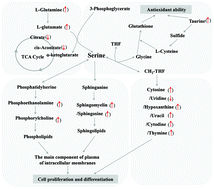Maternal serine supply from late pregnancy to lactation improves offspring performance through modulation of metabolic pathways†
Abstract
Maternal dietary serine affects free amino acid content in milk and the antioxidant ability of progeny. However, whether maternal dietary serine has any effects on offspring performance in pigs and related metabolic consequences remains unknown. This study was conducted to investigate the effects of different levels of maternal dietary serine from late pregnancy to lactation on sow reproductive performance and offspring performance, and on the metabolome of milk and the serum of sows and their offspring. The results showed that sows fed a diet supplemented with 25% serine of the basal diet (L-Ser) had a higher litter weight, and higher average piglet weight at birth and aged 21 days when compared with sows fed the basal diet (CON). We found a large number of metabolites in both colostrum and milk that differed significantly between sows in the CON and L-Ser groups. Additionally, twenty metabolites differed in the serum of piglets aged 21 days between the CON and L-Ser groups. Most of these metabolites are involved in purine and pyrimidine metabolism, glutathione and taurine metabolism, as well as phospholipid and sphingolipid metabolism, which may contribute to the growth-promoting effects of serine on offspring. Our results imply that maternal serine has the potential to improve offspring outcomes.



 Please wait while we load your content...
Please wait while we load your content...